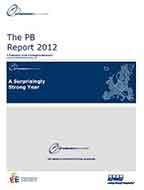PB Annual Report 2012
While 2012 was not an especially good year for global investment banking or capital markets generally, it was an excellent year for privatizations. The total value of privatizations last year, $189.37 billion (€145.66 billion), was the third highest on record and the highest total outside of the immediate post-Crisis period of 2009-10, when banks repurchased shares governments had acquired through rescues. The 2012 total was more than double 2011’s anemic value [$94.4 billion (€68.2 billion)], and no fewer than twelve transactions raised $5.0 billion or more. An additional 32 deals were worth between $1.0 billion and $5.0 billion.
The single largest share issue privatization (SIP), and the largest of all privatization deals during 2012, was September’s seasoned equity offering (SEO) of the U.S. government’s stake in insurance company AIG, which alone raised $18.00 billion (€13.91 billion) for the Treasury. Four other sales of AIG shares brought in $23.61 billion during the year, which—coupled with the offering of shares in AIA in Hong Kong (in March, raising $6.02 billion) and the repurchase by GM of $5.50 billion of its shares—made the United States the world’s leading privatizer for 2012, with a total value of $53.13 billion (€41.05 billion) from seven SIPs.
China was the second leading privatizing country during 2012, with 29 large ($500 million or more) SIPs and private sales raising $41.70 billion (€32.23 billion), nearly triple the 2011 values. As is often the case, the bulk of China’s privatization proceeds came from private placement share offerings by Chinese state-owned enterprises (SOEs) that reduced the state’s equity ownership stake only indirectly, by increasing the total number of shares outstanding. The two largest Chinese privatizations of 2012 were the March and February private placements of the Bank of Communications, and the Industrial Bank, which raised $8.92 billion (€6.82 billion) and $3.80 billion (€2.90 billion) for the companies, respectively. The next largest Chinese privatization was the IPO the insurer PICC, which raised $3.10 billion (€2.38 billion) and was distinctive for having no fewer than 17 investment banks serving as bookrunners (lead underwriters) for its November offering of primary (newly-issued) shares.
Brazil was the third largest privatizer of 2012 on the strength of a single major transaction—the February sale through auction of a 30-year concession to operate and improve the country’s three most important airports, which yielded R$24.5 billion ($14.4 billion; €11.0 billion), far more than expected. The winning bidders, mostly Brazilian pension funds and state-owned enterprises, paid R$16.2 billion ($8.96 billion; €6.84 billion) for São Paulo’s Guaralhas International Airport, five times the minimum bid, and more than eight time the minimum bid price for Brazilia’s airport. This was the first major privatization of President Dilma Rousseff’s administration, and was motivated by the pressing need to upgrade the nation’s infrastructure before hosting the World Cup in 2014 and the Olympics two years later. The next five largest privatizers of 2012–after the United States, China, and Brazil–were Portugal (8 deals; $11.04 billion; €8.36 billion), Japan (2 deals; $10.30 billion; €7.84 billion), Ireland (2 deals; $9.23 billion; €7.00 billion), Russia (3 deals; $7.73 billion; €5.90 billion), and Italy (10 deals; $5.07 billion; €3.96 billion). These sales are described in detail in the next two sections.

